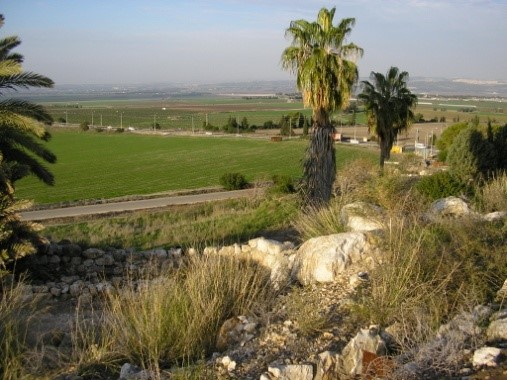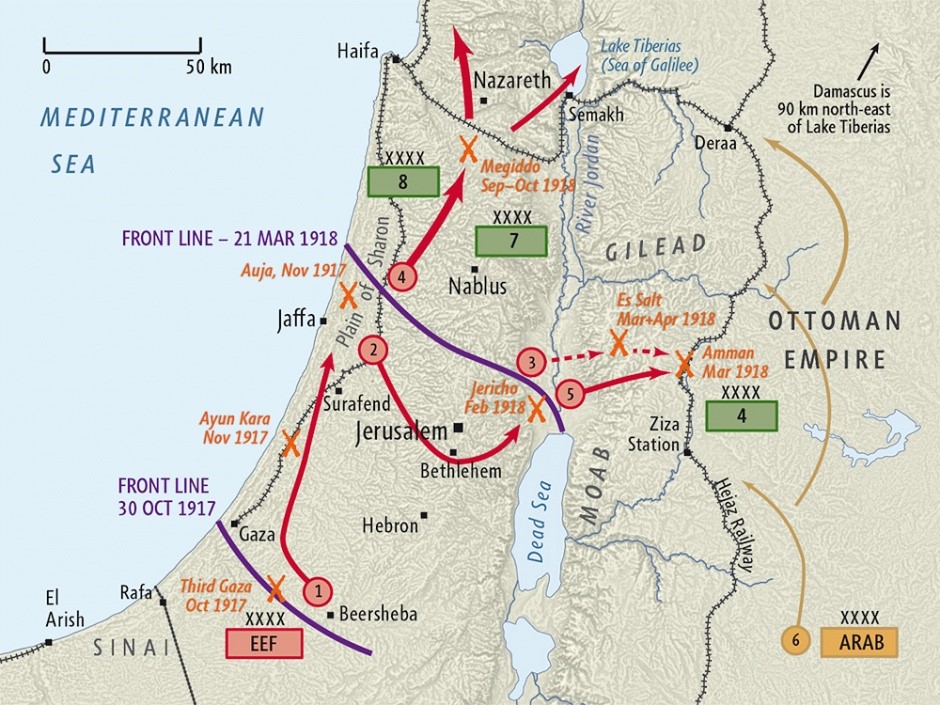 Armageddon (Har Megiddo) has a commanding view over the Jezreel Valley. Much blood has been spilled on these soils as advancing and defending armies clashed in the valley through which the ancient trade route, the Via Maris, passed. It is the epitome of the battle of the ages and according to the Scriptures (Revelation 16:13-16), it will be the site of the final battle. Yet another army was about to cross its path.
Armageddon (Har Megiddo) has a commanding view over the Jezreel Valley. Much blood has been spilled on these soils as advancing and defending armies clashed in the valley through which the ancient trade route, the Via Maris, passed. It is the epitome of the battle of the ages and according to the Scriptures (Revelation 16:13-16), it will be the site of the final battle. Yet another army was about to cross its path.
The Allied forces had to be re-structured and re-trained, as some regiments had been moved to the Western Front in Europe. Now the 4th and 5th Light Horse Brigades (some of whom were formally in the Camel Corps), were supplied with swords and became officially cavalry, joining the British and newly arrived Indians to form the 4th and 5th Cavalry Divisions. General Chauvel commanded these alongside the Australian Mounted Division, which were soon to play yet another key role in the capture of the north.
The Megiddo Sweep

At 4.30 am on September 19, 1918, the artillery guns and bombing aircraft, closely followed by British & Indian infantry broke through the defence line near the coast. Hot on their heels were the newly formed 4th and 5th Cavalry Divisions which dashed through the gap of the dishevelled defence and rode for their lives towards Nazareth where the German commander of the Turkish forces, Von Sanders, had his headquarters, 110 km northeast over the Mt Carmel mountain range. The startled commander managed to escape in his pyjamas just as they arrived.
The reserve Australian Mounted Division followed the two cavalry divisions. The 4th Light Horse Brigade headed for Megiddo and El Afule (today the town of Afula), while the 3rd Light Horse Brigade arrived in Jenin on September 20 to cut off the retreating Turkish army. Eight thousand Turkish prisoners were captured. Several Australians won military awards for their bravery that day. Aerial bombardment destroyed communications centres at El Afule and military headquarters at Nablus (biblical Shechem) and Tul Keram. The English, Irish, Welsh, Indians and ANZACs all did their part to take towns, cut off escape routes and capture guns and people. It was a multi-faceted attack.
The 4th Cavalry Division now headed for Beisan (ancient Beth She’an) where they took out the communications centre so the Turks were unaware of the extent of what was happening. The 8th Turkish army on the coast was put out of action while the remainder of their 7th army fled across the Jordan River. There the Chaytor Force, now under New Zealand General Edward Chaytor, comprising the ANZAC Mounted Division, together with West Indian and Jewish battalions, was awaiting action. It was definitely not a quiet Day of Atonement for the Jews that year.
The fighting continued on several fronts in the following days. On the Mediterranean coast the 5th Cavalry Division took Acre (today Akko) on September 22 while the Indian Lancers dislodged the machine guns protecting Haifa on September 23rd. Over in the east, Chaytor’s Force again entered Es Salt on September 22nd and finally captured Amman, including the citadel, from the 4th Turkish army, taking 2,360 Turkish and German prisoners. The ANZACs were ecstatic to finally attain their prize of Amman after three attempts.
In nine days this division took 10,300 prisoners and 57 guns, with the loss of 139 of their own comrades. Transjordan was now in Allied hands. The Arab army under Emir Faisal and T.E. Lawrence (Lawrence of Arabia) had also finally come good and blown up the railway north and south of the important railway intersection at Dera’a on September 27.
Semakh
 The 4th Light Horse Brigade was given the task of taking the village and strategic railway station at Semakh (today spelt Tzemach) on the southern shores of the Sea of Galilee. It was protected by 13 German machine guns, a 77 mm field gun and several hundred Turkish infantry with grenades. Before dawn on September 25th, two squadrons (from each of the 11th and 12th Light Horse regiments) embarked on a charge – this time in the moonlight before dawn. The enemy fire began before they were within 800 metres of the station, and several horses fell. On reaching the village they fought fiercely but were outnumbered and were rained upon from the Germans shooting from above through the windows of their strong station fort. Only when Australian machine gunners arrived following the charging horses did the tide begin to turn, as they disabled the fire from the windows. The two squadrons then bashed down the door and entered the station going from room to room fighting with rifles, swords and bayonets. It was the bloodiest battle on this operation with 14 ANZACs killed and 64 wounded, together with almost 100 horse casualties, being nearly half of the horse contingent. They killed around 100 opponents (mostly Germans), took 365 prisoners (half of them German) and there were many more wounded. This was one of the last mounted charges in military history as thereafter mechanised transport and tanks were used instead.
The 4th Light Horse Brigade was given the task of taking the village and strategic railway station at Semakh (today spelt Tzemach) on the southern shores of the Sea of Galilee. It was protected by 13 German machine guns, a 77 mm field gun and several hundred Turkish infantry with grenades. Before dawn on September 25th, two squadrons (from each of the 11th and 12th Light Horse regiments) embarked on a charge – this time in the moonlight before dawn. The enemy fire began before they were within 800 metres of the station, and several horses fell. On reaching the village they fought fiercely but were outnumbered and were rained upon from the Germans shooting from above through the windows of their strong station fort. Only when Australian machine gunners arrived following the charging horses did the tide begin to turn, as they disabled the fire from the windows. The two squadrons then bashed down the door and entered the station going from room to room fighting with rifles, swords and bayonets. It was the bloodiest battle on this operation with 14 ANZACs killed and 64 wounded, together with almost 100 horse casualties, being nearly half of the horse contingent. They killed around 100 opponents (mostly Germans), took 365 prisoners (half of them German) and there were many more wounded. This was one of the last mounted charges in military history as thereafter mechanised transport and tanks were used instead.
Before they could rest, the exhausted troops had to press on to Tiberias, a short distance around the western shore of the lake. They arrived by noon and had taken the town by mid-afternoon, with much rejoicing by the mostly Jewish population. With this captured, Galilee was now liberated. The next morning the weary soldiers were ordered to continue around the lake through the villages of Magdala (Mary Magdalene’s birthplace) and Tabgha.
Damascus
The 5th Light Horse Brigade arrived on September 29 in time to catch 4,000 Turkish/German troops escaping Damascus with much loot, heading down the road between the steep cliffs of the Barada Gorge, the route to Beirut. Soon joined by the 3rd Light Horse Brigade (8th, 9th and 10th Regiments), they ruthlessly annihilated the easy targets. This was their revenge for Gallipoli, where the Turks had decimated the 8th and 10th Light Horse Regiments four years earlier. On October 1, they were ordered to cut off the escape route to the north to Homs and Aleppo, and captured 750 Turks and Germans. On October 2 the 9th Light Horse Regiment took another 1,500 prisoners.
 The handover of Damascus was very tricky politically. Britain had made promises to both the French and the Arabs to keep them on their side, but these were somewhat contradictory. Politics demanded that the ‘honour’ of the handover of the city must be given to the Arabs. This would appease them, despite the fact that control would eventually be given to the French. This message had not filtered down to the ANZAC troops although they were halted on the outskirts of Damascus. When Captain Arthur Olden who was second-in-charge of the 10th Light Horse Regiment got his order to cut off the Damascus-Homs road to the north, the quickest way to get there was straight through town. The city was being troubled by factional fighting and disturbances, causing blockages in some of the narrow laneways that went through one of the oldest cities in the world. They found themselves in the city square and Olden was ushered up to the office of the Governor Emir Said and handed the letter of surrender! With this in hand, he proceeded on to complete his task to block the northern exit. When the Arabs arrived the next day, the whole formal process had to be repeated, so the records could be politically correct. After this the city was in such an uproar that the ANZACs were again called in to quell the riots, which they duly did.
The handover of Damascus was very tricky politically. Britain had made promises to both the French and the Arabs to keep them on their side, but these were somewhat contradictory. Politics demanded that the ‘honour’ of the handover of the city must be given to the Arabs. This would appease them, despite the fact that control would eventually be given to the French. This message had not filtered down to the ANZAC troops although they were halted on the outskirts of Damascus. When Captain Arthur Olden who was second-in-charge of the 10th Light Horse Regiment got his order to cut off the Damascus-Homs road to the north, the quickest way to get there was straight through town. The city was being troubled by factional fighting and disturbances, causing blockages in some of the narrow laneways that went through one of the oldest cities in the world. They found themselves in the city square and Olden was ushered up to the office of the Governor Emir Said and handed the letter of surrender! With this in hand, he proceeded on to complete his task to block the northern exit. When the Arabs arrived the next day, the whole formal process had to be repeated, so the records could be politically correct. After this the city was in such an uproar that the ANZACs were again called in to quell the riots, which they duly did.
A New Enemy - Sickness
A new enemy came amongst the troops that attacked large numbers of the soldiers. So many of the 4th Cavalry Division were being hit with malaria and influenza, causing so many deaths that they were unable to proceed. The 5th Cavalry Division continued to push through to Aleppo via Lebanon and Homs, while the Indian infantry and British forces pressed the Turks back along the coast road to Beirut and Tripoli. Aleppo put up stiff resistance and it took several days and back-up troops before the Turks finally surrendered. By this time, the 5th Cavalry Division was also so weak from exhaustion and illness that they could not force the withdrawal. Reserve Indian and Arab troops arrived and more Australian troops were on the way.
Fall of an Empire
When the Allies managed to capture the railway intersection just north of Aleppo, at Muslimile, cutting off any chance of reinforcements or supplies entering the region, their game was over. The Ottoman Empire had fallen. An armistice was arranged for October 30 and enacted on October 31 at midday. The war in the Middle East was finished.
Allenby’s ambitious plan involving 34,000 horsemen against three Turkish armies had paid off. In only six weeks of the Megiddo sweep they covered 560 kms and took 75,000 Turks captive plus capturing 360 guns.
The Australian 1st, 2nd and 3rd Brigades and New Zealand Mounted Rifles were the only troops that had fought in every major battle throughout the campaign. Thoroughly exhausted but with mission accomplished, they now longed for home.
Pictures:
- Jezreel Valley from Har Megiddo – Jill Curry
- Map – Palestine Campaign WW1 - Map produced by Geographx with research assistance from Damien Fenton and Caroline Lord. 'Palestine campaign 1917-18 map', http://www.nzhistory.net.nz/media/photo/palestine-campaign-1917-18-map, (Ministry for Culture and Heritage), updated 14-Aug-2014
- Semakh station – Jill Curry
- A narrow street in the Old City of Damascus – Jill Curry

